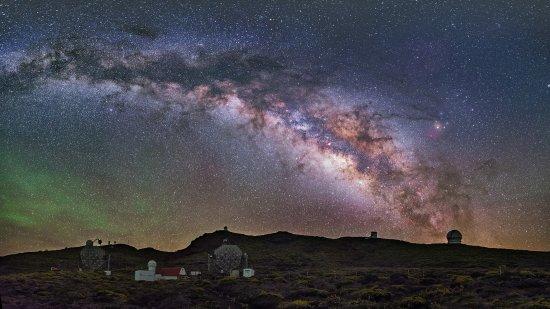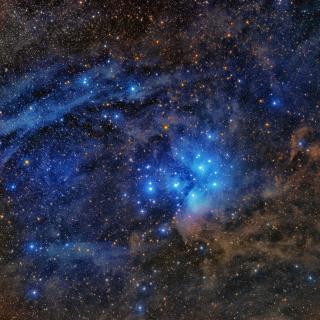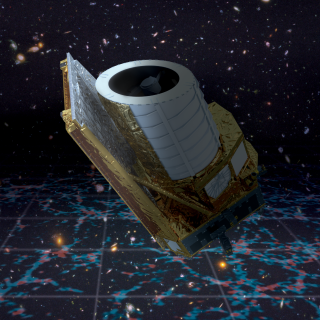The Cherenkov Telescope Array (CTA) Resource Board, which met today in Berlin, has decided to enter into detailed contract negotiations for hosting its major installation in the northern hemisphere on the Roque de los Muchachos observatory (ORM), on the island of La Palma. CTA will be a scientific infrastructure formed by two observatories, one in each hemisphere. At each site there will be an array of Cherenkov telescopes with the most advanced technology for studying high energy gamma rays. The full array is composed of 100 telescopes of which 20 will be in the northern hemisphere.
The director of the Institute of Astrophysics of the Canaries (IAC), Rafael Rebolo, headed the Spanish delegation which participated, together with delegations from 13 other countries (Germany, Austria, Brazil, France, the Netherlands, Italy, Japan, Namibia, Poland, the United Kingdom, the Czech Republic, South Africa, and Switzerland) in the decision which will bring the CTA north to Spain. After months of negotiations and after a careful evaluation of the environmental conditions, the science performance and assessments of construction and operation costs of the candidates, the ORM was placed ahead of the Observatory of San Pedro Martir, in Mexico, with which it was competing in the final round.
The IAC, and the Spanish scientific community coordinated in CTA-España, with the support of the Ministry of Economy and Competitivity and of the Canary Regional Government, have worked from the beginning of the project to attract this important installation to the Canaries. Spain will contribute 40 million euros towards its construction, most of it cofinanced with the European Fund for Regional Development (FEDER). This quantity is around half of the cost of this northern hemisphere astrophysical infrastructure.
Evaluations
Rafael Rebolo, Director of the IAC, which manages the ORM, points out that “The CTA is one of the few scientific infrastructures which Europe has qualified as strategic. The participation of ten European Countries as well as Japan, Brazil, South Africa and the United States make it a genuinely world class project. The sky and the infrastructure of the Roque de los Muchachos Observatory will make it possible that in a few years more than a thousand researchers of the CTA consortium will be able to achieve results of the highest level in the exciting field of High Energy Astrophysics. I would like to thank the Spanish Government and the Government of the Canaries for their strong support of the Spanish candidacy for this, the northern headquarters of the CTA.”
“The selection of the ORM as the site for CTA North” comments Manel Martínez of the Institute of High Energy Physics (IFAE), Barcelona, and the coordinator of CTA-Spain, “is not only a success for the Canary Island Observatories, but is also a recognition of the impact and the visibility of the Spanish scientific community specializing in gamma-ray astronomy. Some 90 scientists of the UCM, IFAE, IAC, UAB, ICCUB, ICE-CSIC/IEEC, CIEMAT, and UJA have worked hard during the past 10 years to make this dream a reality. Now we must keep working in order to place CTA North among the top scientific infrastructures in the world”.
For Ramón García López, Principal Investigator of the CTA at the IAC “The success in bringing CTA North to the Canaries is the result of many people’s work for a number of years, and has been made possible thanks to the institutional support received at insular, regional, and national levels”.
Cherenkov Telescopes
The CTA is an initiative which is planning to build a new generation of Cherenkov Telescopes to study the universe in high energy gamma-rays. These gamma-rays bring us information about the most violent and extreme phenomena in the universe.
The CTA telescopes will have three different sizes. The biggest will be four Large Size Telescopes (LST) with primary mirrors 23 m in diameter, which are being designed by a team of universities and research institutes which, as well as groups from Japan, Italy, France, Germany, Brazil, India, Sweden and Croatia, there are Spanish groups from the University of Barcelona, the IFAE, the CIEMAT, and the Complutense University of Madrid. Within the CTA collaboration there are also groups from the IAC, from the ICE-SCIC/IEEC, and from the Autonomous University of Barcelona and the University of Jaén.
The first LST will be installed next year at the ORM (La Palma). We should point out that at this observatory the Magic telescopes have been in operation for some time. They are considered to be among the best in the world for this range of high energies.
Video animation of the Cherenkov Telescope Array (CTA).Credits: Gabriel Pérez Díaz, IAC (SMM)
Further information:
- Press release of the CTA Consortium
- Press release of the Ministry of Economy and Competitivity



